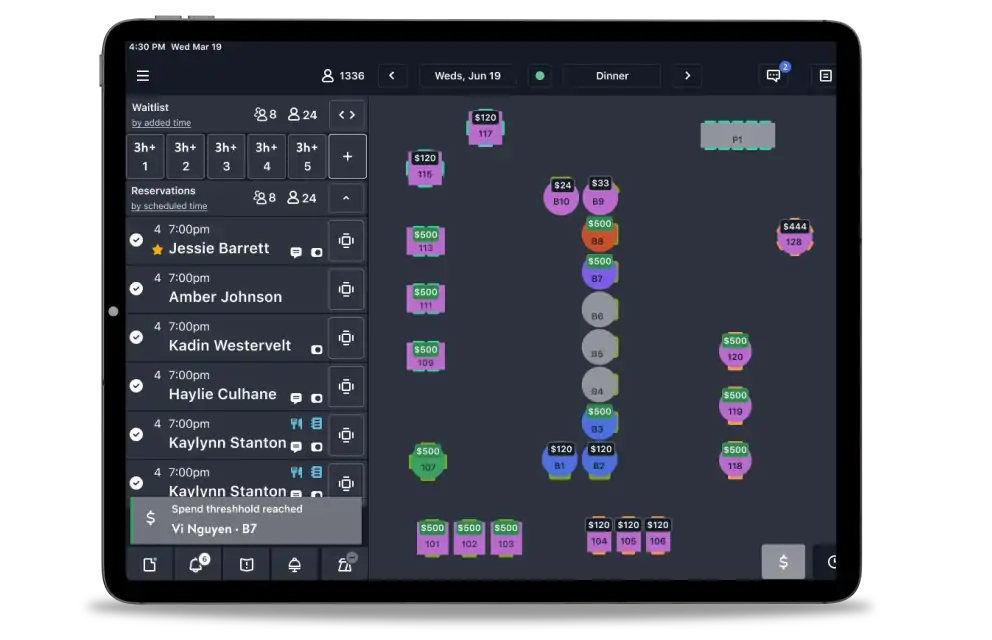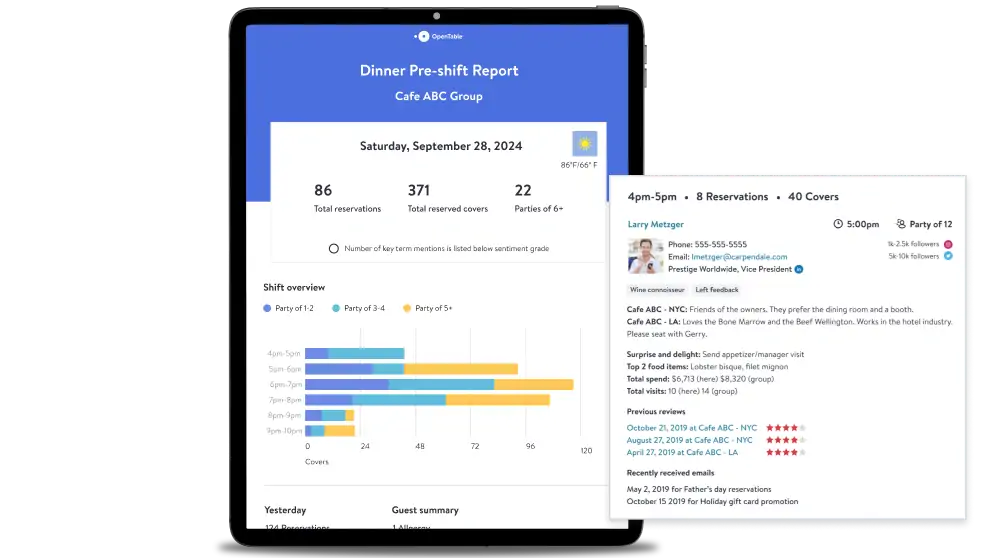- Support
- Take reservations
- Market your restaurant
- Run smoother shifts
- Sell events & experiences
- View all restaurant solutions
- Take reservations
- Market your restaurant
- Run smoother shifts
- Sell events & experiences
- View all restaurant solutions
Your go-to guide for restaurant glossary terms
Ever felt lost in restaurant jargon? Whether you’re a newbie or a seasoned pro, our go-to guide for restaurant glossary terms is here to help. We’ll decode the lingo, so you can focus on what really matters—serving up great experiences. Let’s get you talking like an industry insider.
Front-of-house lingo
Cover
In restaurant terms, a cover refers to each individual seat in the dining area. It’s a key metric for gauging the restaurant’s capacity and helps in planning everything from staffing needs to food orders. Understanding your average covers per night provides helpful insights into your restaurant’s performance. While customer lifetime value looks at what a regular is worth, a cover is a simple metric focused on one single diner.
Turnover rate
The turnover rate measures how many times a table is occupied and vacated during a service period. A higher turnover rate often indicates efficient service and maximized profits. However, it’s a balancing act–you don’t want to rush guests and compromise their dining experience.
Upselling
Upselling is a sales technique where staff encourage customers to go for a more expensive item or add extras to their order. When done right, it boosts the final amount and can also enhance the customer’s experience. Think of suggesting a premium cocktail instead of a house drink or offering a dessert to round off the meal.
Host
The welcoming face of the restaurant, the host is responsible for greeting guests, managing reservations, and guiding them to their tables. They set the tone for the dining experience.
VIP
As a very important person (VIP) you can expect to receive special treatment, such as priority seating or complimentary items. The whole setup is crafted to guarantee an unparalleled dining experience.
Px
An abbreviation for “person,” px is used primarily in reservations. It helps in quickly noting down the number of guests expected.
Regulars
These are the loyal customers who frequent the restaurant. They often have favorite tables or dishes and are highly valued for their repeat business.
Section
Section refers to the specific area of the restaurant a server is responsible for during their shift. It helps ensure efficient service and task distribution, with every server knowing which part of the restaurant is their responsibility.
Campers
A camper is a customer who occupies a table for an extended period without spending much. They can be a challenge when it comes to table turnover rates, and restaurants need to find a balance of letting people relax after a meal without costing too much in the long run.
No-shows
Customers who make a reservation but fail to appear are labeled as “no-shows”. A no-show can disrupt the restaurant’s planning and revenue for the day.
Touching tables
Touching tables is a practice where management or servers briefly visit tables to check on customer satisfaction, address concerns, and enhance the dining experience.
Back-of-house lingo
Mise en place
Mise en place is a mantra focusing on preparation. Originating from France, it means “everything in its place.” Before the kitchen gets hectic with orders, chefs make sure all ingredients are chopped, spices are measured, and utensils are at hand. That’s mise en place in action
86’d
The term “86’d” is restaurant slang you’ll hear when something’s run out or is off the menu. Maybe the chef no longer has a key ingredient, or a dish just isn’t up to par that day. When you hear “86’d,” it means that the item is unavailable for the time being.
On the fly
You’ll often hear “on the fly” in bustling kitchens. It signifies the need for immediate action during service, be it a last-minute menu change or an expedited dish. This phrase calls for swift, efficient execution without compromising quality. It’s the industry’s way of saying, “Do it now, and do it well.”
In the weeds
In the weeds captures the chaos when the kitchen or staff is swamped with orders. It’s when you’re stuck in a tight spot, and it requires quick thinking to navigate out. Every kitchen finds itself “in the weeds” every now and then, but hopefully not too often.
Soigné
Borrowed from French, “soigné” is the epitome of elegance in plating. It goes beyond taste and presents a dish as a work of art, one that captivates all the senses and leaves its mark on the diners who try it.
On the line
Chefs “on the line” are in the heat of the action, cooking and plating dishes. It’s a high-pressure zone where precision and speed are of the essence.
Yes chef
The chef knows best, and “yes chef” is the universal acknowledgment of their command over the kitchen. It signifies a culture of respect and shows that everyone in the kitchen is aligned in their tasks and responsibilities.
Behind
In a bustling kitchen, the term “behind” serves as an important auditory cue and alerts staff that someone is behind them. Saying “behind” is one of the most important terms in the kitchen, as it helps to prevent accidents and maintain a smooth workflow.
On the pass
Dishes that are ready for diners are placed “on the pass.” For all intents and purposes, this is the final checkpoint where the chef guarantees everything meets the restaurant’s high standards before being served.
Chef Mike
Chef Mike is a tongue-in-cheek term for the microwave that adds a dash of humor to the kitchen. While not a replacement for skilled cooking, “Chef Mike” is handy for quick reheats and defrosting tasks.
Fire
Hearing “fire in the kitchen” is a good term, mostly. When you hear it, you’re getting the green light to start cooking a specific dish. It’s a command that sets the kitchen into high gear so that orders are executed in a timely manner.
Line cook
These chefs are the backbone of the kitchen, responsible for cooking and plating dishes. Think of them as the foot soldiers who execute the chef’s vision on a daily basis.
Expeditor
An expeditor role is akin to an orchestra conductor. They organize orders and make sure that dishes from various stations are assembled cohesively and sent out in a timely fashion. The expeditor keeps everything ticking.
Sous chef
As the second-in-command, the sous chef plays a central role in overseeing all the kitchen operations. They often step in for the head chef and are instrumental in staff training and quality control.
Dishwasher
Often the unsung hero of the back-of-house area, the dishwasher is crucial for the smooth running of the kitchen. They ensure a steady supply of clean utensils, which is vital for maintaining the pace of service.
Chef de cuisine
The chef de cuisine is the top chef responsible for the overall vision, menu creation, and management of the kitchen. You could call them the artist whose reputation defines the restaurant.
Prep station
Ingredients need to go through its preparation stage before the cooking begins. The prep station is the starting point, from chopping the vegetables to marinating the meat. This is the bit just before the magic happens, but it’s not less vital.
Chef de cuisine
The chef de cuisine is the top chef responsible for the overall vision, menu creation, and management of the kitchen. You could call them the artist whose reputation defines the restaurant.
Prep station
Ingredients need to go through its preparation stage before the cooking begins. The prep station is the starting point, from chopping the vegetables to marinating the meat. This is the bit just before the magic happens, but it’s not less vital.
Types of restaurants
Fine dining
Fine dining restaurants distinguish themselves through exceptional service and a meticulously curated culinary experience. These high-end venues often feature multiple-course menus crafted by acclaimed chefs, set within an ambiance that exudes elegance. The focus extends beyond sustenance to offer a comprehensive dining experience of the highest caliber.
Fast casual
Fast casual joints bridge the gap between fast food and sit-down dining. They offer the convenience of quick service but in a more relaxed, inviting atmosphere. You’ll often find higher-quality ingredients and the option to customize your meal, all without the formality of a full-service restaurant.
Pop-up
If you’ve ever heard people talking about visiting the new pop-up, you can be sure they’re referring to a short-term event, often set up to trial a new restaurant concept or showcase a unique menu. The concept has exploded in popularity and is a low-risk way for chefs to get creative and gauge public interest, all while offering diners a one-of-a-kind, limited-time experience.
Tasting menu
A tasting menu offers bite-sized portions of diverse dishes that showcase a chef’s flair and imagination. They’re often paired with curated wines or craft cocktails for the best experience.
All-day cafe
An all-day café is the spot for any type of meal, any time. From morning espresso jolt to late-night snack or a laid-back lunch, the all-day cafe has it all and leads the way for convenience.
Diner
With a broad menu that usually includes breakfast items, diners are a haven for late-night eats and comfort food. They’re also a staple of American culture and can be found just about everywhere, from New York to Delaware.
Club
A club offers a full nightlife experience and is where people go to let loose until the early hours of the morning. Many clubs also have a restaurant where you can enjoy a meal before dancing the night away to live music or a DJ set.
Cocktail bar
Cocktail Bars epitomize the art of mixology. With a curated selection of premium spirits and highly skilled bartenders, these establishments offer a sophisticated venue for exploring both innovative and classic cocktails.
Dive bar
Dive Bars are unpretentious and often steeped in local history. They offer a relaxed atmosphere and are the place to enjoy a cold beer, straightforward cocktails, and perhaps a game of pool or darts.
Wine bar
Wine bars boast an expansive selection of vintages that’ll thrill both connoisseurs and casual sippers. Reds, whites, and everything in between, there’s a pour that’s perfect for your palate.
Sports bar
Sports Bars are game-day HQs, usually offering an electric vibe, big screens broadcasting every match, and a menu packed with pub classics. It’s the closest you’ll get to stadium energy—perfect for sports fanatics craving meals, bites, and all the action.
Different types of cuisine
Fusion
Fusion cuisine is the best of both worlds on a plate, depending on your tastes. It’s an innovative cooking style that marries elements from different traditions to create something entirely new. Think sushi tacos or Thai-spiced pizza. It challenges the norms and delights the taste buds, often exciting guests as there are few other restaurants doing the same thing.
Seasonal
Seasonal dining embraces the here and now. It means your menu changes based on what’s fresh and available at the moment. Think summer berries in July and hearty root veggies in December. Seasonal dining is a commitment to quality, sustainability, and a more vibrant plate.
Thai
From Pad Thai to green curry, Thai food is a harmonious blend of complex flavors offering a tapestry of sweet, sour, salty, bitter, and spicy. Thai is a cuisine for the senses, and 11% of all Asian restaurants in the United States serve Thai food.
Indian
Indian cuisine is a sophisticated amalgamation of diverse influences and traditions from across the Asian continent. Thanks to dishes like butter chicken, chana masala, and chicken tikka masala, it offers a rich tapestry of flavors, techniques, and textures that elevate it to a continental experience.
Japanese
The essence of traditional Japanese cuisine champions the use of pristine, locally sourced ingredients like rice, fish, and vegetables. Prepared with meticulous precision, often adhering to time-honored traditions, dishes offer a spectrum of flavors—ranging from mild to robust and occasionally exotic.
Chinese
With a millennia of history, Chinese cuisine is a tapestry of regional flavors and techniques. Today, you’ll find everything from Beijing, Shanghai, Cantonese, and more regions served in all types of restaurants, including takeout spots and fine-dining restaurants.
Italian
While many associate Italian cuisine with pasta dishes and traditional pizza slices, others see it as a tribute to the comforting meals cooked in family kitchens somewhere in Sicily. From seafood along the coast to dishes from the countryside, every dish represents a celebration of flavors and culinary artistry.
Common menu/food phrases
Prix fixe
A prix fixe menu is like a set playlist of dishes at a fixed price. You get an appetizer, main course, and dessert, all decided by the chef. It’s a great way to sample a restaurant’s best hits without the fuss of choosing from a long menu.
À la carte
Unlike a prix fixe menu, à la carte focuses on individual dishes. It’s one of the most popular menu types in restaurants and allows diners to customize their meal, picking multiple dishes and mixing and matching.
Amuse-bouche
It’s not uncommon to find amuse-bouche served in some upscale restaurants. The term refers to a small, complimentary appetizer and is often a way for chefs to showcase their creativity or set the tone for the meal ahead.
Entree
The star attraction of the meal, the main course showcases the chef’s expertise when it comes to flavor and presentation. It serves as the highlight of your dining experience—it’s a dish that will linger in your memory.
Appetizer
Serving as an introduction to the course, starters are the initial dishes served and are often presented in small portions. Ranging from salads to intricate canapés, they stimulate your appetite and set the tone for the meal.
Dessert
The grand finale of the meal, dessert is the sweet course that rounds off the entire experience. From decadent chocolate cakes to refreshing sorbets, desserts are courses that leave a lasting impression.
Bar terms
Well drinks
Well drinks are your go-to cocktails that won’t break the bank. They’re made with the most affordable spirits available at the bar but still pack a punch. They are ideal for casual nights out or when you’re buying a round for the group.
On the rocks
When you order a drink “on the rocks,” you’re asking for your spirit to be poured over ice. It’s a simple yet sophisticated way to enjoy the nuanced flavors of the liquor as it slightly dilutes over time.
Neat
Ordering a drink “neat” is the purist’s choice. It means you’ll get a single, unmixed shot of liquor with no ice, water, or any other additions. It’s the best way to appreciate the spirit’s true character for many spirit connoisseurs.
Manhattan
Originating in the 1880s at New York City’s Manhattan Club, the iconic Manhattan cocktail quickly rose to fame. Though its popularity has ebbed and flowed over the years, it cemented its status as a bar staple during the craft cocktail resurgence. A timeless classic, it continues to captivate drinkers today.
Gin Fizz
First documented in Jerry Thomas’s 1876 “The Bartenders Guide,” the Gin Fizz is essentially the effervescent, protein-enriched relative of Tom Collins. A harmonious blend of gin, lemon, sugar, and soda, this classic cocktail has stood the test of time, offering a frothy twist on a beloved formula.
Margarita
A quintessential summer cocktail, the Margarita is the perfect excuse to dust off that tequila bottle from your holiday travels. Believed to have originated in Mexico between the 1930s and 1940s, this cocktail strikes a sublime balance between sweet and sour, delivering instant refreshment.
Mocktail
A blend of the words “mock” and “cocktail,” the mocktail is a mixed drink containing many of the same ingredients as their boozy counterparts, just without the alcoholic component. Mocktails and non-alcoholic beverages are growing in popularity—OpenTable guest reviews in 2023 saw mentions of “mocktail” jump 48% from the previous year and “non-alcoholic” increase 8%.
Restaurant marketing terms
SEO
Search engine optimization (SEO) is basically your restaurant’s visibility online. Sprucing up your website’s content and layout, as well as ranking for key search terms, will make it easier for Google and other search engines to find you. And the higher you are in those search rankings, the more people will discover your restaurant, and keywords are the magnets that pull readers in.
Customer Lifetime Value
Think about your regulars—the folks who celebrate anniversaries at your tables or swing by every Tuesday. That’s what customer lifetime value is in a nutshell. It’s looking at the long game rather than tallying up a single meal. How much will someone who loves your specials contribute to your bottom line over the years? Knowing your CLV is essential for tailoring your marketing and making sure you’re not just a one-hit-wonder in the restaurant world.
Conversion rate
Think of conversion rates as your digital report card. They show you how many people who visit your website or social media channels actually take action, like making a reservation. It’s a key metric that helps you understand if your online efforts are paying off.
ROAS
Return on ad spend is a marketing metric that measures the amount of revenue generated for every dollar spent on advertising. Tracking ROAS helps you determine the efficiency of a marketing campaign so you can make strategic decisions about how to optimize your efforts. OpenTable marketing campaigns are easily tracked and guarantee ROAS—you only pay for seated guests.
Tech terms
POS
The Point of Sale system, or POS as it’s commonly known, is the heartbeat of your restaurant’s operations. It’s where transactions happen, orders are processed, and payments are made. Modern POS systems do more than just handle cash—they integrate with inventory management and even customer loyalty programs. It’s a must-have for any restaurant aiming for efficiency and excellent customer service.
CRM
Customer Relationship Management (CRM) software helps restaurants maintain customer interactions through the use of data. You can keep a record of important guest information, such as dining preferences and past orders. This info can then be used for targeted marketing campaigns and as a way to make the service feel more personalized. A CRM system enhances customer loyalty and drives repeat business.
KDS
The kitchen display system (KDS) is a must-have for any busy kitchen. It replaces more old-school methods like printed or handwritten tickets and makes orders easier to read via a digital screen. With a KDS, you can streamline the cooking and assembly process and reduce human error while speeding up service.
TMS
A table management system (TMS) is an essential tool that helps restaurants track and optimize table usage in their dining space. It can help with reducing wait times, increasing table turnover to maximize revenue, and improving the overall dining experience for guests.
OpenTable
OpenTable connects diners with available tables at the restaurants they love, making the booking process fluid and seamless. But OpenTable is more than a restaurant booking platform—you get a suite of integrated features, including reservation management, customer reviews, email marketing, and much more. OpenTable helps restaurants to optimize operations and enhance the dining experience.
Let’s do this
SolutionsWhy OpenTableMoreGET OPENTABLE
Need help deciding which option is best for you? Give us a call at
Join us onCopyright © 2024 OpenTable, Inc. 1 Montgomery St Ste 500, San Francisco CA 94104 – All rights reserved.OpenTable is part of Booking Holdings Inc., the world leader in online travel & related services.







